|
|
|
Top Gun: "Humble Henry" Rivers
2004 IBS Score Shooter of the Year
Other Guns of the Week >
Back in the late '60s, Henry Rivers (then just 19 years old) showed up at a Columbia, SC shootin' match and boldly announced that his fellow shooters might as well pack up and go home because he would outshoot them all. Well, that day Henry ended up dead last, earning the "Humble Henry" moniker that has stuck with him ever since. Henry competed in local BR matches until 1980 or so, then took an extended hiatus to concentrate on family and career. Henry jumped into the BR scene again in the year 2000. After hooking up with Joe Entrekin and learning to master the 30BR, Henry soon became one of the nation's top shooters. In 2002 he won the SE Regional Championship (Sporter Class). In 2003 he won the IBS Long-Range Nationals in Thurmont, MD, and the West Virginia State Championship. In 2004, he broke a couple world records, took the Georgia and NC State Championships and ended up IBS Score Shooter of the Year. Not bad for a self-described "simple country boy". Along with friend and shooting partner Joe Entrekin (and bullet-maker Randy Robinett), Henry has pioneered the 30BR, helping it to become the cartridge of choice for Benchrest Score competition.
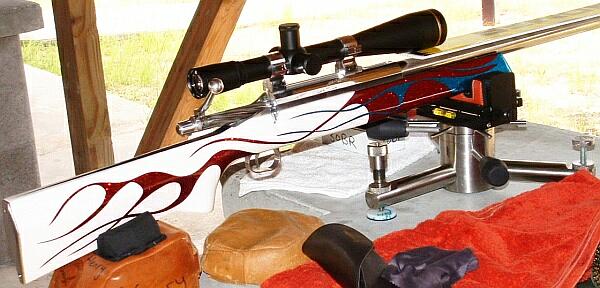
Henry's "9/11"--a Patriotic Rifle Fit for a Champion
This patriotic 30BR is Henry's primary competition gun, and the one with which he earned most of his major match victories. Henry named the gun "9/11" since it was completed the week the twin towers fell. Henry's 9/11 features a Stolle Teddy action, and a 22.5" Krieger 1:18 twist 4-groove barrel in Heavy Varmint contour. Henry chambered and installed the barrel himself. Most of his other guns also sport Kriegers, but he has one Kostyshyn 1:17 and he says it shoots exceptionally well also. The stock is a Bruno McMillan with about 1.5 pounds of weight permanently installed in the butt. The spectacular red, white and blue metallic paint job (with 32 coats of clear) was done by Blake Long of Lexington, SC. All-up weight is 13 pounds, 3 ounces. On top of the action sits a Leupold 45X competition scope in double-screw Kelbly 30mm rings. Henry had Premier Reticles install a tiny 1/16 MOA target dot. Henry likes the extra precision he gets with the super-small dot.
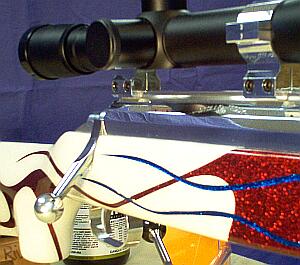 Case Prep and Reloading Methods Case Prep and Reloading Methods
Henry follows most of the established methods for precision reloading, with a few extra tricks. He forms 30BR cases from Lapua brass with an expander mandrel, then neck-turns them using a Nielsen "Pumpkin" neck-turning tool and a Craftsman power drill. He says "the Nielsen gives me a beautiful, even cut in one pass." Neck-wall thickness is .010" checked with a tubing micrometer. This gives him a .3285"-neck loaded round for a .330" chamber. He cuts the primer pockets to even depth and reams the flash-holes to .0625" with a Hoehn tool. Before he loads the cases, he'll full-length size the cases and bump the shoulders back .003". This way he says "the only contact is the bullet in the lands and the base of the case."
After shooting the cases he is pretty fastidious with his brass. He'll clean carbon off the necks with steel wool, then remove carbon from the primer pockets with his primer uniformer. Then he tumbles the brass after each firing. When they're bright and shiny he runs the brass through a Harrell's full-length bushing sizing die with a .326" TiNitride Redding bushing--that gives him about .002" tension. He sets the die to bump about .0015"-.002" each time. That's about it, though he'll re-trim the brass to square the necks about once each season. One thing he doesn't do normally is anneal the cases: "Unlike Joe, I don't do a lot of annealing. I'm still shooting my original brass from four years ago for the 9/11 gun. Those cases have held up for over 6000 rounds with no annealing and no split necks."
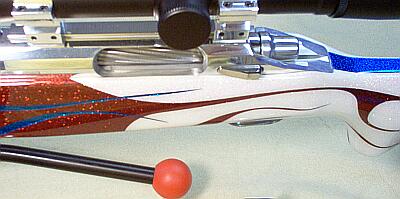 Preferred Load Preferred Load
Henry has been shooting the same load for a number of years now: 34.5 grains of Hodgdon H4198 Extreme, with Federal 205m primers. This works out to about 63 clicks on a Harrell's measure. At all distances he uses BIB 118gr 10-Ogive flat-based bullets, which he coats with Danzac (Tungsten Disulphide) in a power tumbler. He always pre-loads before the match. Henry tells us the 30BR is not fussy about loads--in virtually all ambient conditions he can use the same load. This gives the 30BR a big advantage over the 6PPC Henry believes. At a match, between relays, he can relax or watch the wind conditions while the PPC shooters fuss with their ammo.
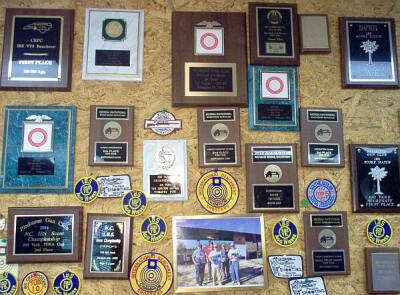 Mastering the 30BR Mastering the 30BR
Henry's involvement with the 30BR was not an overnight success. In 2000-2002 he was shooting a 6PPC and getting involved with Score shooting. Then he met up with Joe Entrekin. He asked if he could shoot Joe's 30BR. In that first session, Henry managed to shoot a .220" 100-yard 10-shot group at 100 yards. Henry tells us: "I was very impressed. During a two-hour drive home I decided I want to shoot that cartridge. I said to myself, 'Gosh that shoots as good as my PPC and the recoil isn't bad at all.' My friends said I was crazy--that I would end up just wasting a bunch of money. But, I was kind of stubborn--I thought the 30BR had potential that other shooters didn't see--shooting Joe's rifle really opened my eyes."
Henry had a Teddy action (with a .308 bolt-face) in an old Hall-pattern stock. He had smith Ronnie Long build up a 30BR using the .010" freebore reamer that Ronnie and Randy Robinette used. With the new Bruno stock, that became the 9/11 gun (with stock work by Billy Stevens). It did shoot well and Henry won some matches. But, he told us, "When I first got the gun I thought it was going to be the 'magic pill', but I learned there is nothing free--it would take time to master". It took Henry one full season to learn how to shoot the 30BR: "I won a match or two but I started dropping points here or there. Frustrated, I asked Randy Robinett if this was just something about the caliber--did they drop a bullet every now and then? I got discouraged and went back to the 6PPC and had the same problems. So I went back and learned to drive the 30BR--working hard on developing the right shooting technique. I learned that those dropped shots were caused by 'driver error'. The gun was very accurate. But I was not handling the gun on the bags the way I should. I learned that there was nothing wrong with the gun--my gun-handling, what I call 'table manners', wasn't right. You need to drive a 30BR the same way all the time. Consistency is key. It seems like the 30 has twice the recoil of the 6ppc. But I think the recoil multiplies the error. I think if you're recoil sensitive you'll really have to work at it." But work at it he did, and the rest, as they say, is history. Yep, we'd say Henry has done pretty well with 9/11 and his other 30BRs--just check out that wall of awards.
More of Henry's Arsenal
Most of us would be delighted to have just one gun capable of winning big-time matches. Henry has four 30BRs currently, any one of which can win on a given day. Here's "Lucky", set up with a polished Panda Action, Krieger 1:18" barrel in a Kelbly Klub stock with adjustable weight system. Paintwork by Kelbly. Henry will be campaigning "Lucky" this year, along with two other 30s, his new Pearl White "Casper" and his bright yellow "Tweety Bird". Henry is still tuning "Lucky" to get it up to the performance level of the 9/11 gun, but he reports that he really likes the Kelbly Klub stock. The finish is gorgeous and, with its low center of gravity, the Klub tracks beautifully. |
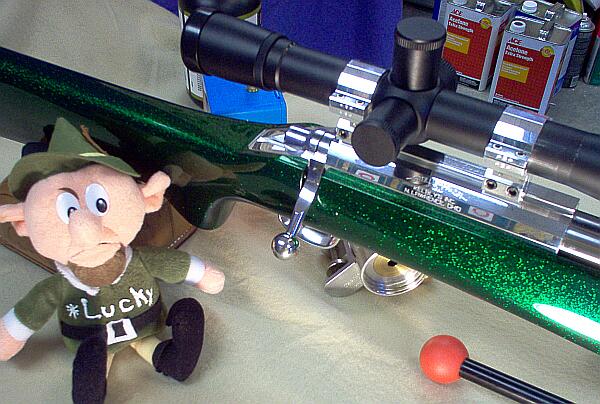
| Interview with "Humble Henry" Rivers |
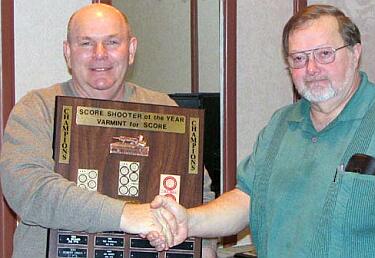 Henry Rivers (that smiling fellow holding the 2004 Shooter of the Year award) will tell you he's just a simple ol' country boy, but this man really has a wealth of knowledge. With experience spanning two generations, he can regale you with stories of the "founding fathers" of competitive BR. We were delighted that Henry offered to share some of his thoughts about the 30BR and Benchrest in general. Henry Rivers (that smiling fellow holding the 2004 Shooter of the Year award) will tell you he's just a simple ol' country boy, but this man really has a wealth of knowledge. With experience spanning two generations, he can regale you with stories of the "founding fathers" of competitive BR. We were delighted that Henry offered to share some of his thoughts about the 30BR and Benchrest in general.
Q: How do you compare Benchrest shooting today with the sport as you knew it in the '70s and '80s?
It is amazing how much this sport has changed. The accuracy has increased so much. The bullets are better, the barrels are better, and there have been some major improvements in stock design. Plus the whole process of putting together a match gun is different. You used to just tell a smith just to build a gun. Now you specify everything--stocks, rings, reamer dimensions, barrels. There are so many good components now that a shooter has many more great choices than ever before. Whether you prefer a Stolle, or a BAT, or a Stiller--they're all good now. Pretty much all of the modern components have something about them that is positive.
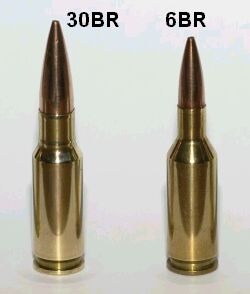 Q: What does the future hold for the 30BR cartridge? Q: What does the future hold for the 30BR cartridge?
The 30 has really come to life in the last couple years. After Joe and I started doing pretty well now a lot of the people are shooting it. I think the 30BR will do to the 6x47 in Score shooting what the 6PPC did to the 222 in group shooting--basically drive it off the firing line. And in five years we may see 30BRs used successfully in group shooting as well--but probably with different bullets than we are using today. I believe Brady Knight and Tom Delaney have already won some group matches with 30BRs. Now, I know that suggesting that the 6PPC may have rivals in group shooting is controversial. I'm not saying 30BR shooters will dominate group shooting, but I think they'll be competitive. The hard part will be driving the gun.
Q: How would you describe your shooting style?
With the 30 BR, you've got to stay with the gun until the recoil comes back. I tell people "You've got to go to sleep with the gun," meaning being real steady through the whole process. I don't put any cheek pressure on the stock. My thumb is straight up and down in the vertical position on stock. I don't grip the gun, but I do put very heavy pressure with my shoulder against the buttstock, pushing the gun against the front of the rest. The Farley rest I use now doesn't move.
There is a trick to this "push" technique. The secret is that you want to make sure the vertical cross-hair stays vertical. I'll push in, then back off a bit, watching the vertical cross-hair. As long as the vertical cross-hair stays vertical I feel good about the gun's position. Then I'll push back in with my shoulder and load up the pressure before I finally break the shot.
Q: Will you be crossing over into group shooting at some point?
It is hard to be good at more than one discipline--that is why I don't group shoot and I don't shoot PPC anymore. I'm concerned that if I go to a caliber that recoils less, my technique will deteriorate. That light recoil of a 6PPC will cover up a lot of bad habits. Then if you go back to the 30BR you have problems.
Q: When you're at the top of your game, is it just a subjective feeling of being "in the zone", or is there something specific you've observed?
I know I'm really shooting well if, when I pull the trigger, I can actually see the muzzle flash. That's one way I can tell when I'm really concentrating. When I can actually see that brief gray or orange flash then I know my technique was right and the shot will fly to point of aim.
Q: Have you tried free-recoil with the 30BR?
I tried free recoil and I got vertical. I tried taking my hand and gripping the stock. That didn't work for me with the 1.5 ounce trigger. So I developed the technique I use now. It works for me.
Q: Do you think there is one best way to shoot a 30BR?
You need to do what works for you. Nobody can do it for you. It's like a golf swing. If it feels good, if it works, and you're comfortable with it then that's the best for you. Joe Entrekin shoots free recoil. Other people grip their 30BRs. The most important thing is what I call "table manners"--the way you handle the gun on the bench. Shooting a 30BR successfully requires impeccable "table manners". Repeatability is the key to accuracy with this caliber--doing the same thing every time.
Q: Do you have a "match strategy" you use in competition?
To the extent I have a strategy, it has to do with wind. I try to look for the predominant wind at that particular range. Most locations have a predominant condition that will show up sooner or later. I'll pay attention to shifts but try to wait for the predominant wind, and shoot in that when I go to sighter target. If that doesn't work, I'll try to run with the secondary condition. I use a LOT of sighter shots. That way I try to be "dead on" in prevailing conditions. Whenever possible I don't hold off. But at 200 yards, sometimes you do have to hold off if you get caught in a shift.
I want to say something about sighters. To me they are vital. I shot 68 sighters at 300-yard match once. Many times I would have dropped points if I hadn't shot a sighter. I always go pre-loaded to a match, and I bring plenty of ammo.
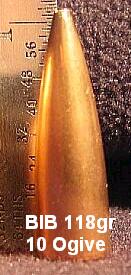 Q: You shoot with Randy Robinett's BIB bullets. Have you tried other brands? Q: You shoot with Randy Robinett's BIB bullets. Have you tried other brands?
I tried some Fowlers, and they shot well. But it seems like Randy's have a little bit of an edge at 200 yards. Plus Randy is a pleasure to deal with. I shoot mostly BIB 118gr 10-ogive bullets, but I've tried Randy's 112s and 125s. The 7-ogives 112s did well in my new gun. But I've had so much luck with the 118s, that's what I'll keep shooting for now.
Q: You shoot coated bullets. What advantages do they offer?
I coat my bullets with Danzac, which is Tungsten Disulphide. I couldn't say Danzac prolongs barrel life, but I do find I can clean less. With the coated bullets, I can go a whole match without cleaning. That's as many as 132 rounds since I shoot a lot of sighters. I use Danzac rather than moly because it has a higher temperature rating and it seems to clean up easier than moly. There is also a slight velocity edge with Danzac. My Danzac-coated load runs about 3015 fps compared to 2980 fps or so I was getting with naked bullets.
Q: One of our readers wanted to know if you've considered using a different caliber or heavier bullets?
The Hunter Benchrest shooters run the 30x47 and many similar wildcats. But they do so because of the capacity requirements. The 30BR is an incredibly efficient and accurate cartridge. If we went any bigger I think that would just burn more powder and increase recoil. I don't think anyone wants to go smaller, as the case capacity gives us good velocities right where it is. Same thing with heavier bullets--it just means more recoil with no accuracy advantage.
Q: How about powders? You and Joe Entrekin both shoot H4198. Is there anything better out there?
Among the powders that work well with the 30BR, it seems that H4198 Extreme is the least sensitive to temperature changes. H322 is good, but it seems a little dirtier and more temperamental. With H4198 if something goes wrong, I know it's me and not the powder. However, when I change H4198 lot numbers, I always weigh the new lot to calibrate my Harrell's measure--I don't just assume I can run exactly the same clicks as before.
Q: Do you ever tune your load for the particular conditions?
Never. I've been shooting the same load for four years, 34.5 grains of H4198 with 118gr BIBs. That's the great thing about the 30BR. It's not fussy. I've shot that load from 17 degrees in Charlotte, NC to 103 degrees in Dublin, Georgia. It seems to make no difference. By contrast the 6PPC is finicky and sensitive to temp and humidity.
Q: What's your cleaning procedure?
I start with the GM Top Engine Cleaner, a carbon solvent. I'll run three or four soaking wet patches on a spire-point jag though the barrel. With the barrel still wet, I'll put JB on a dry patch and short-stroke that through the barrel. Then I'll repeat a second time. I usually start with a 1 3/8" square patch first, then follow with a tighter-fitting 1 3/4" patch. After that I'll run a couple wet patches to clear the JB, then dry patch. That does the job. People worry that JB wears out your barrel. With my procedure I haven't found that to be the case. The 9/11 gun's barrel has 6400 rounds through it and it's still winning.
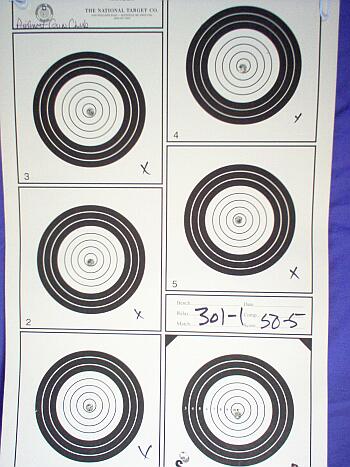 Q: How important is formal practice in maintaining a high skill level? Q: How important is formal practice in maintaining a high skill level?
Practice is important. Not many weeks go by when I don't pull the trigger. I usually make it to the range once a week and fire from 50 to 100 rounds.
But you need to practice in the right way. Just pulling the trigger is plinking, not practicing. I told one friend who shot without flags "you're just wasting ammunition." If you want to practice effectively, you need to do the same things you do in the match. Set up the wind flags, set up the rest the same way each time. You have to practice good habits. Try to simulate match conditions as much as possible, so you develop consistency. You need to try to shoot even under pressure. That teaches good habits.
Q: Do you recommend shooting rimfire guns as part of a practice regimen?
Not really. Shooting rimfires may help with trigger control, but there is a world of difference with the recoil of the 30BR.
| One of Henry's 100-yard targets from the Piedmont match. |
Q: What's the best way to learn what it takes to do well?
Try to make friends with someone who has shot for awhile. Get with somebody that shoots. Listen to everyone. Most people are very willing to help. But in particular, talk to people that WIN. Talk to the people that consistently win.
Q: Do you have any advice for newcomers to the Score Shooting game?
Well, the Benchrest game is expensive, but money won't buy you a win! Don't go out on a limb and spend your life savings before you know something about the sport. Time in the saddle is the only thing that will really help. And practice. Nothing takes the place of shooting. If you don't go out there and shoot early and often you can have the best equipment in the world but you won't be able to realize its potential.
Q: What components do you recommend?
If you're looking to build or buy a gun, go to a few matches and try the different stocks and actions. I love my Stolles, but there are other equally good actions. Try different port configurations and look through different scopes. I recommend starting out with a used rifle. You can get a good used BR gun for $1500-$1800. And 30BR barrels last a long, long time. I haven't had to replace a 30BR barrel yet. The barrel on 9/11 is still winning after four years, with over 6400 rounds through it. But buy from someone local whom you know and trust.
Q: Do you prefer glue-in actions or pillar-bedded actions?
Both set-ups can shoot very well. I understand the arguments in favor of glue-ins, but since I do most of my own barrel work, I prefer pillar bedding. It's much easier to do the barrels with a screw-in action.
Q: Good optics obviously are very important with the kind of accuracy you demand. What scopes do you recommend?
I use a Leupold 45X competition scope with a 1/16 moa dot. The Weaver is a good sound scope but the optics are better on the Leupold--it's clearer, brighter, and sharper. I've tried the old Bausch and Lomb 36x, and they really are very nice--good glass and repeatable clicks. I'll say one thing about scopes though--it doesn't matter how good the glass is, if the clicks aren't 100% reliable. Just this past weekend I encountered a scope-related issue. My X-count was low, and I just couldn't figure it what was going wrong. Joe let me borrow a Weaver T-36 for the last two relays and bingo, X count went right up and my elusive accuracy problem went away. So my 45X scope is going back for a fix. I learned that mechanical reliability is the most important thing in a competition scope.
Q: What do you think of the claims that somebody's factory rifle will shoot "quarter MOA all day long."
Well, it seems everyone has a wallet group to brag about. But we all know that doesn't mean anything unless the gun can shoot that well ALL the time. Repeatability is the key. In IBS Score shooting, keep in mind that only 6 or 7 guys have ever shot a perfect score in competition with 25X. Joe Entrekin is one of them. It's funny, many of those guys who brag about their little groups never seem to make it to the matches.
Q: Some people may wonder why you're willing to share your shooting secrets. After all you said yourself it took much effort to learn to handle the 30BR correctly.
Why not share the information? If somebody reads this and it works, more power to him. I think the "elder statesmen" should share what they've learned. We have to get the young shooters interested in the shooting sports. They are the future of the sport.
Moreover, I've benefitted from many other guys like Joe who have helped me over the years. I try to listen to everyone. Everyone can teach you something. You're never "too good" to learn. If it's something useful I may try it.
Just a few years ago, people were saying Joe and I were crazy for trying out the 30BR. We took a lot of ridicule. I remember in 2002 going up to Thurmont, Maryland and seeing a sign that said "30BR Graveyard". Yet Joe and I made a respectable showing. When we first went up to Thurmont, there were just two or three 30BRs. At the most recent match, half the field was 30BR. None of that would have happened if people in the shooting community weren't willing to help one another. Just last week, Mike Rippey won a match with a Farley-actioned 30BR I sold him and helped him tune. I was delighted to see the progress he's made, and I felt like a proud father watching him get the first-place trophy.
Photos by Joe Entrekin and Henry Rivers. Bullet image by Randy Robinett, Case image by Jim DeKort. All content Copyright © 2005, 6mmBR.com, All Rights Reserved. No reproduction of any content without advanced permission in writing.
Topics: IBS, Shooter of the Year, Score, 100 yards, 200 yards, 30BR, 30 BR, BIB, Robinett, Joe Entrekin, Henry Rivers, Ronnie Long, Record, 300 yards, Score, Group, Agg, Aggregate, Benchrest, .308, 6mm, 6mm BR, 6BR, 6mm Improved, Light Gun, 6PPC, Hart, Krieger, South Carolina, NBRSA, Remington 40X, Brady Knight, Leupold, Weaver, NightForce scope, Jewell, Benchrest, BR, Bench Rest, Single-shot, competition, Rifle, Accuracy, Wind, BC, Ballistics, Norma, Hodgdon Powder, Varget, 4198, H4198, H322, RL15, Reloader, Sierra, MatchKing, Competition Shooting, Stocks, Bruno, Kelbly, Hart, stainless barrel, reloading, powder, case forming, neck-turning, Lapua Brass, bullets, precision.


|
|